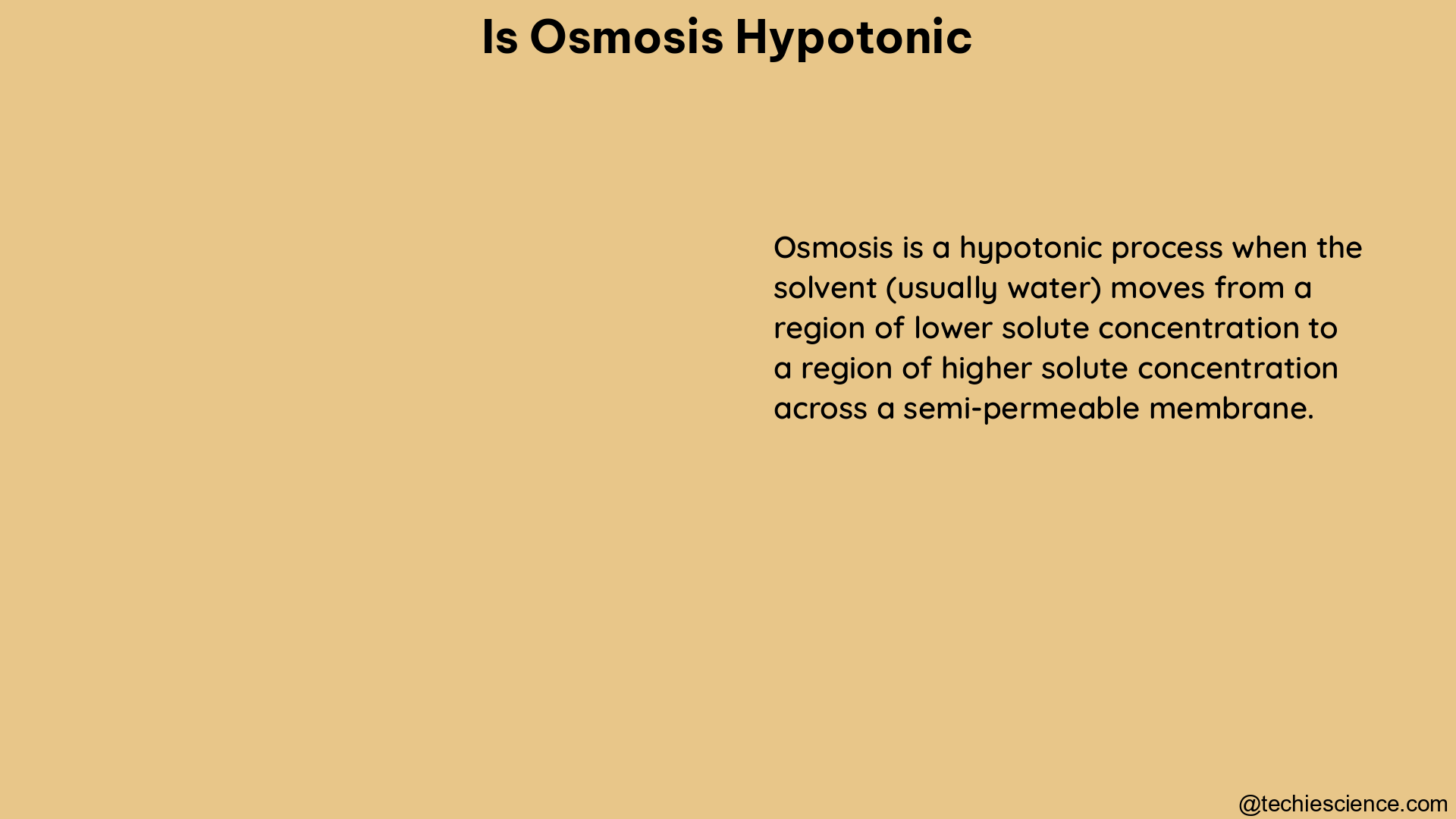Osmosis is a fundamental biological process that involves the movement of water molecules through a selectively permeable membrane from a region of higher water potential (lower solute concentration) to a region of lower water potential (higher solute concentration). When the concentration of solutes on either side of the membrane differs, the solution with a lower solute concentration is considered hypotonic, while the solution with a higher solute concentration is hypertonic. In a hypotonic solution, the water potential is higher than that of the cell, causing water to move into the cell, potentially leading to its bursting if the concentration difference is significant.
Understanding Osmosis and Tonicity
Osmosis is a passive transport process that occurs due to the difference in the concentration of solutes on either side of a selectively permeable membrane. The movement of water molecules is driven by the difference in water potential, which is influenced by the concentration of solutes.
Tonicity and its Types
Tonicity refers to the relative concentration of solutes on either side of the membrane. There are three main types of tonicity:
-
Hypotonic: The solution has a lower solute concentration than the cell, resulting in a higher water potential. This causes water to move into the cell, potentially leading to cell swelling and bursting.
-
Hypertonic: The solution has a higher solute concentration than the cell, resulting in a lower water potential. This causes water to move out of the cell, leading to cell shrinkage and plasmolysis.
-
Isotonic: The solution has the same solute concentration as the cell, resulting in no net movement of water across the membrane.
Factors Affecting Osmosis
Several factors can influence the rate and direction of osmosis, including:
-
Membrane Permeability: The selective permeability of the membrane determines which molecules can pass through and at what rate.
-
Solute Concentration: The difference in solute concentration between the two solutions drives the movement of water.
-
Temperature: Increased temperature can enhance the kinetic energy of water molecules, leading to a faster rate of osmosis.
-
Pressure: Applying external pressure can affect the direction and rate of osmosis, as described by the principles of osmotic pressure.
Quantifying Osmosis: Experimental Approaches

To measure osmosis quantitatively, researchers often conduct experiments involving the change in mass of a substance due to the movement of water.
Potato Experiment
In this experiment, the mass of a potato is measured before and after immersion in a salt solution of varying concentrations. The resulting change in mass can be used to determine the osmotic pressure and water potential of the solution.
- Procedure:
- Weigh a potato sample and record its initial mass.
- Immerse the potato in a salt solution of known concentration.
- Measure the mass of the potato after a specified time interval.
-
Calculate the change in mass and relate it to the osmotic pressure and water potential of the solution.
-
Calculations:
- Percent change in mass = (Final mass – Initial mass) / Initial mass × 100
- Osmotic pressure = -RTc, where R is the gas constant, T is the absolute temperature, and c is the molar concentration of the solute.
- Water potential = Solute potential + Pressure potential
Dialysis Tubing Experiment
In this experiment, a dialysis tubing bag is filled with a glucose solution and immersed in a solution of varying glucose concentrations. The change in mass of the bag is used to calculate the concentration of glucose and water inside the bag, providing a quantitative measure of osmosis.
- Procedure:
- Weigh the empty dialysis tubing bag and record its initial mass.
- Fill the bag with a glucose solution of known concentration.
- Immerse the filled bag in a solution with a different glucose concentration.
- Measure the mass of the bag after a specified time interval.
-
Calculate the change in mass and use it to determine the glucose and water concentrations inside the bag.
-
Calculations:
- Percent change in mass = (Final mass – Initial mass) / Initial mass × 100
- Glucose concentration inside the bag = (Initial glucose mass) / (Final volume of solution inside the bag)
- Water concentration inside the bag = (Final volume of solution inside the bag – Initial volume of glucose solution) / (Final volume of solution inside the bag)
These experimental approaches provide a quantitative understanding of the osmotic processes and the factors that influence them, such as solute concentration, membrane permeability, and temperature.
Implications of Hypotonic Conditions
In a hypotonic solution, the concentration of solutes is lower than that of the cell, leading to a net movement of water into the cell. This can result in an increase in the cell’s volume and turgor pressure, potentially causing it to burst if the concentration difference is significant.
Cell Swelling and Bursting
When a cell is placed in a hypotonic solution, water moves into the cell due to the difference in water potential. This can lead to an increase in the cell’s volume and turgor pressure, which can ultimately cause the cell to burst if the concentration difference is too great.
- Factors Affecting Cell Bursting:
- Magnitude of the concentration difference between the cell and the solution
- Permeability of the cell membrane to water
-
Strength and elasticity of the cell wall or membrane
-
Consequences of Cell Bursting:
- Release of cellular contents
- Disruption of cellular homeostasis
- Potential cell death
Importance of Turgor Pressure in Plants
In plant cells, turgor pressure is essential for maintaining the structure and strength of the plant. Turgor pressure is generated by the net movement of water into the cell, which creates a positive pressure within the cell.
- Role of Turgor Pressure:
- Provides rigidity and support to plant tissues and organs
- Facilitates the opening and closing of stomata for gas exchange
-
Enables the movement of water and nutrients within the plant
-
Consequences of Decreased Turgor Pressure:
- Wilting of plant tissues and organs
- Reduced gas exchange and photosynthetic efficiency
- Impaired transport of water and nutrients
To ensure the proper functioning of plant cells and the overall health of the plant, it is crucial to maintain appropriate water potential and osmotic pressure within the cells.
Conclusion
Osmosis is a fundamental biological process that involves the movement of water molecules through a selectively permeable membrane. When the concentration of solutes on either side of the membrane differs, the solution with a lower solute concentration is considered hypotonic. In a hypotonic solution, the water potential is higher than that of the cell, causing water to move into the cell, potentially leading to its bursting if the concentration difference is significant.
Quantifying osmosis through experiments, such as the potato and dialysis tubing experiments, provides valuable insights into the water potential and osmotic pressure of solutions. Understanding the implications of hypotonic conditions, particularly the effects on cell swelling, bursting, and the importance of turgor pressure in plants, is crucial for maintaining the proper functioning of biological systems.
By exploring the intricacies of osmosis and the specific case of hypotonic conditions, this comprehensive guide aims to equip readers with a deeper understanding of this fundamental biological process and its practical applications in various fields of study.
References:
– Osmosis Lab Example 2
– AP Lab 1: Osmosis Sample 3
– Osmosis Lesson

I am Trisha Dey, a postgraduate in Bioinformatics. I pursued my graduate degree in Biochemistry. I love reading .I also have a passion for learning new languages.
Let’s connect through linked in: